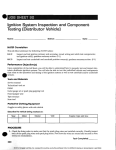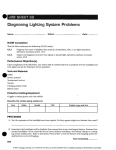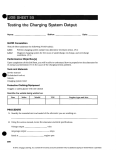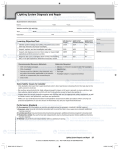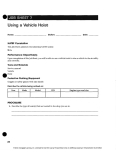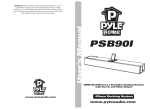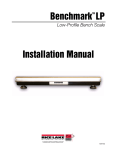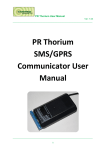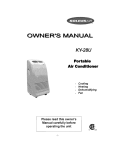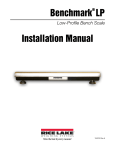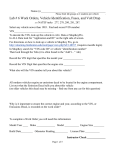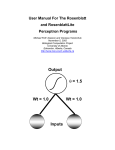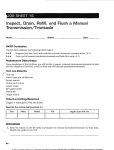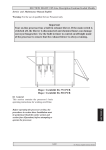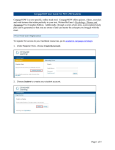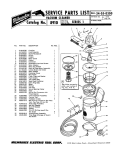Download Inspecting and Cleaning the Battery Cables and Connections
Transcript
• JOB SHEET 42 Inspecting and Cleaning the Battery Cables and Connections Name: -------------------------- Station: --------------------- Date: ________ NATEF Correlation This Job Sheet addresses the following NATEF task(s): Inspect, clean, fill, and/or replace battery, battery cables, connectors, clamps, and holddowns. (P-1) 6.B.4 Performance Objective(s) Upon completion of this Job Sheet, you will be able to understand how to inspect, clean, remove, and install a battery, the cables, and holddown apparatus. Tools and Materials • Voltmeter Battery terminal cleaner/brush Service manual Technician's tool set Vehicle Baking soda or battery cleaning solution Battery terminal remover Wire brush Protective Clothing/Equipment Goggles or safety glasses with side shields Describe the vehicle being worked on: Year Make Model VIN Engine type and size PROCEDURE . 1. Describe the general appearance of the battery. • 164 © 2012, Cengage Learning, Inc. Licensed for one-time use by the purchaser only; no additional copying or retransmission is permitted. Job Sheet 42 • 165 2. Describe the general appearance of the battery terminals and cables. 3. Check the tightness of the battery cables. Are they tight? 4. With the ignition in the on position, use the voltmeter to measure the amount of voltage drop from the battery positive terminal to the battery positive cable (while it is still attached). 5. Do your answers from steps 3 and 4 indicate that there might be a problem? 6. Describe the condition of the battery holddown . • (a) Holddown J-bolts Figure 26.21 Different types of battery holddowns. 7. Turn the key off and remove the battery cables and holddown apparatus. • Note: You may have to use the battery terminal remover to remove some stuck cables. Task Completed _ _ __ 8. Remove the battery and place it on a bench. Task Completed _ _ __ © 2012, Cengage Learning, Inc. Licensed for one-time use by the purchaser only; no additional copying or retransmission is permitted . 166 • Job Sheet 42 9. Describe the condition of the battery tray. 10. Using the wire brush, a baking soda and water solution, or a battery terminal cleaning solution, clean the battery cables, holddown, and tray. Task Completed _ _ __ Figure 27.4 A battery terminal cleaner that cleans both the inside of the clamp and the outside of the post. 11. After cleaning, inspect the battery cables. Do they still have corrosion on them? 12. If the battery has removable caps on it, remove them and check the fluid level. • Warning: Do not use a flame light to look inside the battery. Use a flashlight. Batteries emit hydrogen gas, which is explosive! Task Completed _ _ __ Figure 26.8 This battery has removable cell caps. 13. Fill the battery with clean, distilled water (do not use tap water and do not overfill). Task Completed _ _ __ 14. Reinstall the battery, cables, and holddown. Task Completed _ _ __ • © 2012, Cengage Learning, Inc. Licensed for one-time use by the purchaser only; no additional copying or retransmission is permitted . Job Sheet 42 • 167 Problems Encountered INSTRUCTOR EVALUATION D D D D D 4 3 2 1 0 Mastered Task Able to Perform Task Independently; Some Additional Training Suggested Able to Perform Task with Close Supervision; Requires Additional Training Unable to Perform Task Not Attempted Comments • Instructor Name: - - - - - - - - - - - - - - - - - - - - - - - - Date: _ _ _ _ _ __ Instructor Signature: - - - - - - - - - - - - - - - - - - - - - - - - - - - - - - - - - • © 2012, Cengage Learning, Inc. Licensed for one-time use by the purchaser only; no additional copying or retransmission is permitted. • JOB SHEET 43 Perform a State-of-Charge Battery Test Date: ________ Name: --------------------------- Station: --------------------- NATEF Correlation This Job Sheet addresses the following NATEF task(s): Perform battery state-of-charge test; determine necessary action. (P-1 ) 6.B.l Performance Objective(s) Upon completion of this Job Sheet, you will be able to understand how to perform a battery state-ofcharge test. Tools and Materials • Voltmeter Service manual Hydrometer or refractometer Technidan's tool set Battery with removable caps Infrared temperature gun Protective Clothing/Equipment Goggles or safety glasses with side shields Describe the vehicle being worked on: Year Make Model VIN Engine type and size PROCEDURE 1. Remove the battery caps and check the fluid level. Warning: Do not use a flame light to look inside the battery. Use a flashlight. Batteries emit hydrogen gas, which is explosive! Task Completed _ _ __ • 168 © 2012, Cengage Learning, Inc. Licensed for one-time use by the purchaser only; no additional copying or retransmission is permitted. Job Sheet 43 • 1 &9 2. Does the battery have a built-in hydrometer? If yes, describe what you see in the sight glass. Green dot 65% or above state of charge Dark Top of Clear Below65% state of charge battery Sight glass Low level electrolyte Figure 27.27 A built-in hydrometer in a sealed battery indicates the condition of the battery. 3. What is the temperature of the battery case? • 4. Measure the specific gravity of each cell using the hydrometer or refractometer and record it below. Celll Cell2 Cell3 Cell4 CeliS Cell6 Figure 27.24 Draw electrolyte into the hydrometer. • © 2012, Cengage Learning, Inc. Licensed for one-time use by the purchaser only; no additional copying or retransmission is permitted. 170 Job Sheet 43 • (b) Figure 27.30 (a) Removing an electrolyte sample from the battery. (b) Reading the strength of the sample with the refractometer. 5. With respect to the temperature, list the corrected specific gravity of each cell. Celll Cell2 c•u3 Cell4 CeliS Cell6 6. Fill the battery with clean, distilled water (do not use tap water and do not overfill). Task Completed _ _ __ What is the open drcuit voltage of the battery? 8. Do your corrected spedfic gravity readings correlate to the open circuit voltage? Acid content 1.260 1 .260 • 1.260 1.195 1.250 1.250 Figure 27.26 Hydrometer readings should vary no more than 0.050. This battery has a defective cell . © 2012, Cengage Learning, Inc. Licensed for one-time use by the purchaser only; no additional copying or retransmission is permitted . Job Sheet 43 • 171 9. Based on your testing, does the battery require replacement or recharging? Problems Encountered INSTRUCTOR EVALUATION D 4 Mastered Task D 3 Able to Perform Task Independently; Some Additional Training Suggested D 2 Able to Perform Task with Close Supervision; Requires Additional Training D 1 Unable to Perform Task D 0 Not Attempted • Comments InstructorName: ------------------------------------------------ Date: ______________ Instructor Signature: ----------------------------------------------------------------- • © 2012, Cengage Learning, Inc. Licensed for one-time use by the purchaser only; no additional copying or retransmission is permitted . • JOB SHEET 44 Charging a Battery Name: --------------------------- Station:--------------------- Date: ________ NATEF Correlation This Job Sheet addresses the following NATEF task(s): Perform battery charge. (P-1) 6.B.5 Performance Objective(s) Upon completion of this Job Sheet, you will be able to understand how to perform a battery state-ofcharge test. Tools and Materials • Voltmeter Service manual Technician's tool set Fender cover Battery charger Protective Clothing/Equipment Goggles or safety glasses with side shields Describe the vehicle being worked on: Year Make Model VIN Engine type and size PROCEDURE 1. Place the fender covers on the fender closest to the battery. Task Completed _____ • 172 © 2012, Cengage Learning, Inc. Licensed for one-time use by the purchaser only; no additional copying or retransmission is permitted . Job Sheet 44 • 173 2. If equipped, remove the battery caps and check the fluid level. Fill the battery with clean, distilled water (do not use tap water) if needed and reinstall the battery caps (do not overfill the battery). Warning: Do not charge the battery if the fluid inside is frozen! Note: If the battery is a sealed design, use a noncontact thermometer or a temperature probe to get an indica- tion if the battery is frozen. Task Completed _ _ __ • Figure 3.28 Careless use of the battery charger caused this battery to explode . 3. Remove the battery terminals and move the cables to the side. Task Completed _ _ __ 4. What is the open circuit voltage of the battery? • Figure 27.32 Reading open circuit voltage with a digital voltmeter. 5. Check that the charger is turned off and connect the battery charger cables to the battery. Warning: Be sure that you have a good connection so that you do not produce a spark. Batteries produce a hydrogen gas when charging. Task Completed _ _ __ © 2012, Cengage Learning, Inc. Licensed for one-time use by the purchaser only; no additional copying or retransmission is permitted. Job Sheet 44 174 Turn the charger on to the setting for a slow charge. What is the amperage on this setting and how long would you leave it on? 7. Turn the charger on to the setting for a fast charge. What is the amperage on this setting and how long would you leave it on? 8. Explain the situations in which you would use a slow charge or a fast charge. Problems Encountered INSTRUCTOR EVALUATION • 0 0 0 0 0 4 3 2 1 0 Mastered Task Able to Perform Task Independently; Some Additional Training Suggested Able to Perform Task with Close Supervision; Requires Additional Training Unable to Perform Task Not Attempted Comments Instructor Name: - - - - - - - - - - - - - - - - - - - - - - - - Date: _ _ _ _ _ __ Instructor Signature: - - - - - - - - - - - - - - - - - - - - - - - - - - - - - - - - - • © 2012, Cengage Learning, Inc. Licensed for one-time use by the purchaser only; no additional copying or retransmission is permitted. • JOB SHEET 45 Jump-Starting a Battery Name: ______________ Station: _ _ _ _ _ _ _ _ _ __ Date: _ _ __ NATEF Correlation This Job Sheet addresses the following NATEF task(s): 6.B.6 Start a vehicle using jumper cables or an auxiliary power supply. (P-2) Performance Objective(s) Upon completion of this Job Sheet, you will be able to understand how to properly jump-start a vehicle using a live battery in a vehicle and an auxiliary power supply (booster pack). Tools and Materials • Battery jumper cables Vehicle with a live battery Vehicle with a dead battery Auxiliary power supply (booster pack) Protective Clothing/Equipment Goggles or safety glasses with side shields Describe the vehicle being worked on: Year Make Model VIN Engine type and size PROCEDURE 1. What are the gauge size and length of the battery jumper cables you are using? 2. Position the vehicle with the live battery so that the jumper cables will not be stretched. Task Completed _ _ __ 3. Open the hood of both vehicles. Task Completed _ _ __ • 4. Make sure that the ignition is in the off position on both vehicles. Task Completed _ _ __ 175 © 2012, Cengage Learning, Inc. Licensed for one-time use by the purchaser only; no additional copying or retransmission is permitted . 176 Job Sheet 45 Connect one end of the positive jumper cable to the dead car's positive battery terminal. Task Completed _ _ __ Make last connection, 4, away from battery Black (negative) Good battery NEGa·ePOS Smaller Larger Top-terminal batteries Figure 3.29 Correct connections for jump-starting a car. Connect the other end of the positive jumper cable to the live car's positive battery terminal. Task Completed _ _ __ 7. Connect one end of the negative jumper cable to the live car's negative battery terminal. Task Completed _ _ __ 8. Connect the other end of the negative jumper cable to the dead car's engine ground. Task Completed _ _ __ 9. Start the engine on the live car and wait a minute. Task Completed _ _ __ 10. Attempt to start the dead car. Once the dead car starts, remove the negative jumper cable from the engine ground. Task Completed _ _ __ 11. Remove the negative jumper cable from the live car. Task Completed _ _ __ 12. Remove the positive jumper cable from the live car. Task Completed _ _ __ 13. Remove the positive jumper cable from the dead car. Task Completed _ _ __ • 14. Now connect the auxiliary power supply (booster pack) to the dead vehicle's battery in the same manner as you did before, but skipping the "live car" steps. Task Completed _ _ __ © 2012, Cengage Learning, Inc. licensed for one-time use by the purchaser only; no additional copying or retransmission is permitted . Job Sheet 45 • 177 15. If the auxiliary power supply (booster pack) has an on/off switch, tum it on now. Task Completed _ _ __ 16. Start the engine of the dead car. Task Completed _ _ __ 17. Tum the engine off and turn the switch on the auxiliary power supply (booster pack) off. Task Completed _ _ __ 18. Remove the cables from the auxiliary power supply (booster pack) and remove it from the vehicle. Task Completed _ _ __ 19. Explain what could possibly happen if you connected the dead car's battery jumper cables to both the positive and negative terminals. Problems Encountered • INSTRUCTOR EVALUATION D D D D D 4 3 2 1 0 Mastered Task Able to Perform Task Independently; Some Additional Training Suggested Able to Perform Task with Close Supervision; Requires Additional Training Unable to Perform Task Not Attempted Comments Instructor Name: - - - - - - - - - - - - - - - - - - - - - - - Date: _ _ _ _ _ __ InstructorSignature: - - - - - - - - - - - - - - - - - - - - - - - - - - - - - - - - - • © 2012, Cengage Learning, Inc. Licensed for one-time use by the purchaser only; no additional copying or retransmission is permitted. • JOB SHEET 46 Perform a Battery Capacity and Conductance Test Name: --------------------------- Station:--------------------- Date: ________ NATEF Correlation This Job Sheet addresses the following NATEF task(s): 6.B.2 Perform battery capacity test; confirm proper battery capacity for vehicle application; determine necessary action. (P-1) 6.A.2 Identify and interpret electrical/electronic system concern; determine necessary action. (P-1) Performance Objective(s) Upon completion of this Job Sheet, you will be able to understand how to perform a battery test using both the capacity and conductance methods . • Tools and Materials Capacity (load) tester Conductance tester Protective Clothing/Equipment Goggles or safety glasses with side shields Describe the vehicle being worked on: Year Make Model VIN Engine type and size PROCEDURE 1. Explain the difference between a conductance test and a capacity test . • Note: Steps 2-8 are for perfonning a capacity test. 178 © 2012, Cengage Learning, Inc. Licensed for one-time use by the purchaser only; no additional copying or retransmission is permitted. Job Sheet 46 • 179 2. What is the battery CCA? 3. What is the open circuit voltage of the battery? 4. Does the battery require charging before testing? Note: If the battery open circuit is less than 12.4 volts, recharge it before performing the capacity test. 5. Connect the battery capacity tester clamps to the battery. Make sure they are on tight. Task Completed _ _ __ Ammeter Voltmeter • Carbon pile Inductive pickup "' @ "' ~ ~ = ~ l'l g Figure 27.41 Parts of a volt-amp tester. 6. Based on the battery rating, how much load should be applied to the battery during the capacity test? 7. Conduct the battery capacity load test. Voltage dropped t o - - - - - - - - - - - - - - - volts Load was held f o r - - - - - - - - - - - - - - - - seconds 8. Did the battery pass the capacity (load) test? • 9. Is there enough power (current capacity) to meet the minimum requirements for this vehicle? Note: Steps 10-13 are for performing a conductance test. © 2012, Cengage Learning, Inc. Licensed for one-time use by the purchaser only; no additional copying or retransmission is permitted. 180 • Job Sheet 46 10. Connect the battery conductance tester to the battery terminals. Task Completed _ _ __ 11. Follow the tester's instructions by entering the CCA into the tester screen. Task Completed _ _ __ 12. Conduct the battery conductance test. Task Completed _ _ __ 13. What were the results of the test? 14. If this Job Sheet is for a live customer, do you think that this testing series provides sufficient infor- mation to determine the customer's problem? Why or why not? Problems Encountered •--------------------INSTRUCTOR EVALUATION D D D D D 4 3 2 1 0 Mastered Task Able to Perform Task Independently; Some Additional Training Suggested Able to Perform Task with Close Supervision; Requires Additional Training Unable to Perform Task Not Attempted Comments Instructor Name: - - - - - - - - - - - - - - - - - - - - - - - - Date: _______ Instructor Signature: - - - - - - - - - - - - - - - - - - - - - - - - - - - - - - - - - • © 2012, Cengage Learning, Inc. Licensed for one-time use by the purchaser only; no additional copying or retransmission is permitted. • JOB SHEET 47 Battery Removal and Installation Name: ---------------------------- Station:---------------------- Date: _____ NATEF Correlation This Job Sheet addresses the following NATEF task(s): 6.B.3 6.B.8 Maintain or restore electronic memory functions. (P-1) Identify electronic modules, security systems, radios, and other accessories that require reinitialization or code entry following battery disconnect. (P-1) 6.B.4 Inspect, clean, fill, and/or replace battery, battery cables, connectors, clamps, and holddowns. (P-1) Performance Objective(s) • Upon completion of this Job Sheet, you will be able to understand how to remove and reinstall a battery and how to use a memory saving device . Tools and Materials Service manual Technician's tool set Vehicle Memory saving device Protective Clothing/Equipment Goggles or safety glasses with side shields Describe the vehicle being worked on: Year Make Model VIN Engine type and size PROCEDURE 1. Record the radio station presets . • 181 © 2012, Cengage Learning, Inc. Licensed for one-time use by the purchaser only; no additional copying or retransmission is permitted. 182 Job Sheet 47 Refer to the owner's or service manual. Does the vehicle you are working on have a security system on the radio? Note: If the vehicle does have a security system installed on the radio you may need to reinitialize the system or enter a code following a battery disconnect. Refer to the service manual for instructions on retrieving and entering the code. 3. Install the memory saving device. Note: Some memory saving devices are installed in the cigarette lighter and others use the battery terminals. Task Completed _ _ __ • Figure 27.10 A tool for keeping computer memory alive while a battery is removed for service. 4. Remove the battery negative cable. Task Completed _ _ __ 5. Remove the battery positive cable. Task Completed _ _ __ 6. Remove the battery holddown apparatus. Task Completed _ _ __ 7. Clean the battery holddown, tray, and cables as needed. Note: See fob Sheet #42 for the procedures for cleaning. Task Completed _ _ __ 8. Reinstall the battery and holddown apparatus. Task Completed _ _ __ • 9. Connect the positive cable to the battery. Task Completed _ _ __ © 2012, Cengage Learning, Inc. Licensed for one-time use by the purchaser only; no additional copying or retransmission is permitted. Job Sheet 47 • 183 10. Connect the negative cable to the battery. Task Completed _ _ __ 11. Remove the memory saving device. Did the memory saving device work? 12. If the memory saving device did not work, you will need to set the radio station presets, clock(s), and seat memory positions. Task Completed _ _ __ Problems Encountered INSTRUCTOR EVALUATION • D D D D D 4 3 2 1 0 Mastered Task Able to Perform Task Independently; Some Additional Training Suggested Able to Perform Task with Close Supervision; Requires Additional Training Unable to Perform Task Not Attempted Comments InstructorName: ------------------------------------------------ Date: ______________ Instructor Signature: ------------------------------------------------------------------ • © 2012, Cengage Learning, Inc. Licensed for one-time use by the purchaser only; no additional copying or retransmission is permitted. • JOB SHEET 48 Identifying Hybrid Electric Vehicle High-Voltage Circuits, Safety, and Precautions Name: --------------------------- Station: --------------------- Date: ________ NATEF Correlation This Job Sheet addresses the following NATEF task(s): 6.8.7 Identify high-voltage circuits of electric or hybrid electric vehicle and related safety precautions. (P-3) 6.8.9 Identify hybrid vehicle auxiliary (12v) battery service, repair, and test procedures. (P-3) 8.F.7 Identify hybrid vehicle internal combustion engine service precautions. (P-3) Performance Objective(s) • Upon completion of this Job Sheet, you will be able to describe how to safely handle and identify a hybrid electric vehicle and related components. Tools and Materials Service manual High-voltage gloves Protective Clothing/Equipment Goggles or safety glasses with side shields Describe the vehicle being worked on: Year Make Model VIN Engine type and size PROCEDURE 1. Describe the location of"the high-voltage service plug (also known as the disconnect plug). • 2. Gain access to the service switch . 184 © 2012, Cengage Learning, Inc. Licensed for one-time use by the purchaser only; no additional copying or retransmission is permitted. Job Sheet 48 • 185 3. Compare those readings to what the manufacturer specifies. Is there a difference? 4. Do the pressure readings indicate that the warning light should be on? 5. Gain access to the service manual. Describe how this specific type of TPMS works. Task Completed _ _ __ Problems Encountered • INSTRUCTOR EVALUATION 4 3 D 2 D 1 D 0 D D Mastered Task Able to Perform Task Independently; Some Additional Training Suggested Able to Perform Task with Close Supervision; Requires Additional Training Unable to Perform Task Not Attempted Comments Instructor Name: - - - - - - - - - - - - - - - - - - - - - - - - Date: _ _ _ _ _ __ Instructor Signature: - - - - - - - - - - - - - - - - - - - - - - - - - - - - - - - - - • © 2012, Cengage Learning, Inc. Licensed for one-time use by the purchaser only; no additional copying or retransmission is permitted.























